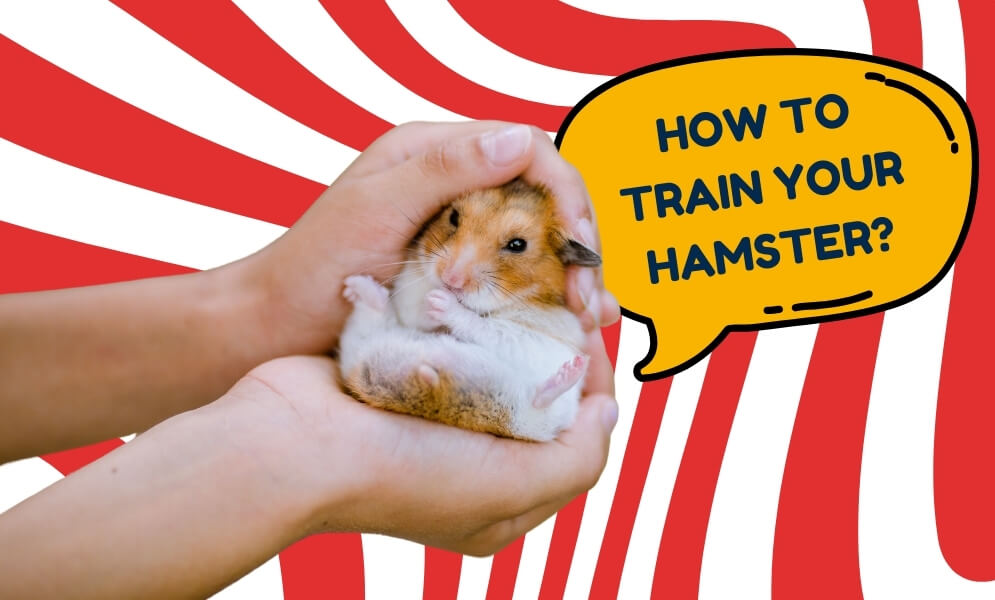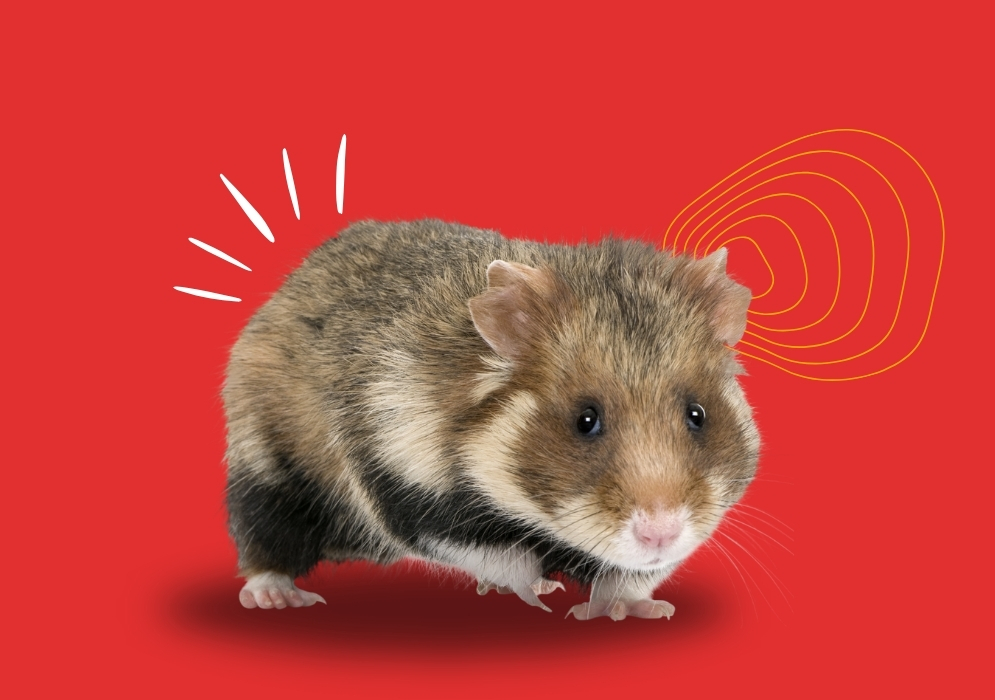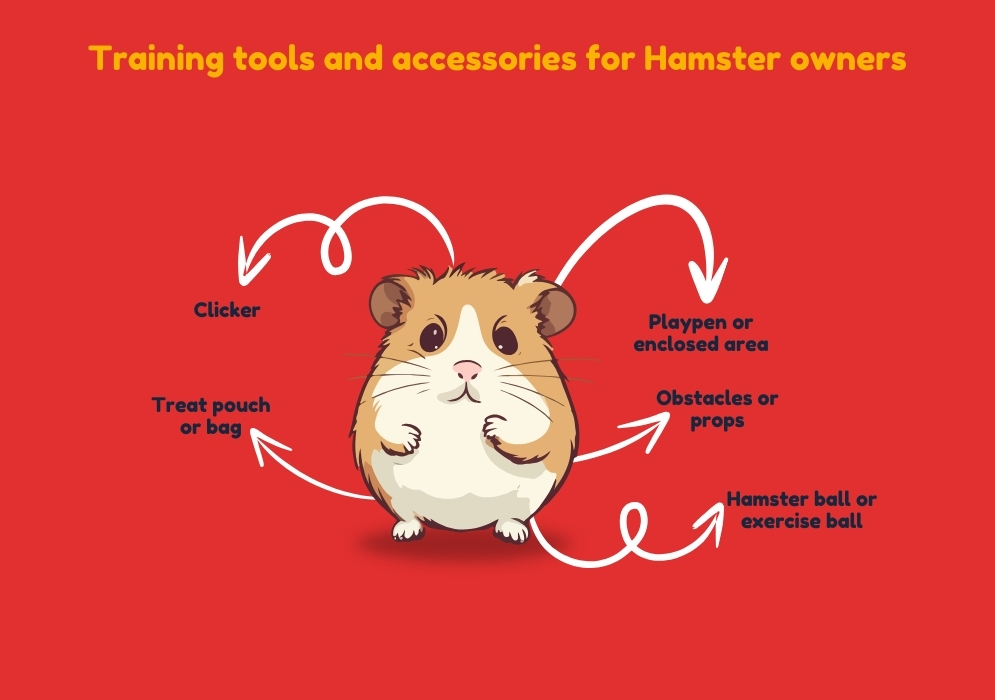How to Train Your Hamster: Simple Tips and Techniques For Beginners


You have just brought home a cute furball of a hamster, and now you are wondering how to train a hamster. Well, training an animal as small as a hamster might seem like a daunting task at first. But we assure you, with the right tips and techniques, you can easily train your hamster.
Training your hamster can prove to be incredibly rewarding and fun for both of you. It is because it will not only help strengthen the bond between you two but also provide mental stimulation and enrichment for your pet. A well-trained hamster is more likely to be responsive, obedient, and less prone to stress or anxiety.
If you are still hesitating about training your hamster, let us tell you that it can help the hamster become more socialized and comfortable with human interaction. In turn, it will make it easier to handle them during playtime or grooming sessions. It’s a fantastic way to keep your hamster’s mind active and engaged, preventing boredom and potentially destructive behaviors.
First, Get To Know your Hamster Well!

Before you dive into the world of hamster training, you need to take some time to get to know your hamster and give it some time to get used to you. It will help you to understand your pet’s nature, habits, and preferences.
This is important because hamsters are often underestimated because of their size. But the truth is they are intelligent and curious creatures. They also have unique personalities and quirks. Some might be more food-motivated, while others respond better to positive reinforcement through praise or gentle petting.
So, for the first few days after you bring your hamster home, observe your hamster’s body language and vocalizations to gauge their mood and behavioral traits. You can start introducing yourself to your hamster as soon as it settles in a bit. When you see your hamster eating and drinking normally, you will know that it has finally settled in and feels comfortable in its surroundings.
How To Properly Handle a Hamster?
When your hamster has had some time to adjust to its new surroundings and is eating and drinking as usual while you are present, you can start interacting and handling them. But since hamsters are so tiny and delicate, you must exercise caution while handling them. Here are some tips on how you can do so:
- Get them used to your presence: Spend time near their cage, speaking softly or reading aloud to help them get accustomed to your voice and scent⁵.
- Wash your hands: Use unscented soap to avoid confusing your hamster with strong smells.
- Approach slowly: Place your hand in the cage and let your hamster come to you. Offer treats to encourage them.
- Scoop gently: Form a cup with both hands on either side of their body and scoop them up securely. Hamsters are delicate, so it’s important to handle them with care to avoid injury.
- Avoid sudden movements: Hamsters tend to get stressed easily, so move slowly and calmly to prevent startling them.
- Support their body: Always support their body with both hands to make them feel secure.
Lastly, handle your hamster regularly to build trust and reduce their fear of being held.
Getting Started: Preparing the Training Environment
Now that you know how to handle a hamster correctly, you should start by creating the right environment for training a hamster. Since hamsters are sensitive to loud noise or vibrations, you should choose a quiet, distraction-free area in your home. It will make your hamster feel comfortable and safe.
Also, make sure you have all the necessary training tools, such as treats (their favorite foods or small pieces of fresh fruits or vegetables), a clicker (optional), and any props or obstacles you might need for specific tricks. It’s also a good idea to have a small, enclosed space like a playpen or a large, shallow box to contain your hamster during training sessions.
Basic Commands: Teaching Your Hamster to Come When Called

One of the most essential commands to teach your hamster is to come when called. This will not only make handling and playtime easier but also help ensure your pet’s safety in case of an accidental escape.
- Step 1 Start by associating a specific sound or verbal cue, like a whistle or a simple word, with a reward. Every time you make the sound or say the word, offer your hamster a treat.
- Step 2 Once your hamster has made the connection between the cue and the reward, begin calling them from a short distance away as they come to you, praise and reward them immediately.
- Step 3 Gradually increase the distance and complexity of the environment, ensuring your hamster consistently responds to the cue before moving on.
Remember, consistency and patience are key when teaching any new command or trick.
How To Teach Your Hamster To Perform Advanced Tricks
After mastering the basics, you can move on to more advanced tricks like spinning or jumping through hoops. These tricks not only showcase your hamster’s intelligence but also provide excellent mental and physical stimulation.
Teach Your Hamster To Spin
To teach your hamster to spin, hold a treat near their nose and slowly move it in a circular motion. As your hamster follows the treat, they’ll naturally start to spin. Reward them immediately after each successful spin.
Teach Your Hamster To Jump
For jumping, start by placing a low obstacle (like a small book or a cardboard tube) in front of your hamster. Lure them over the obstacle with a treat, rewarding them as soon as they make the jump.
While teaching advanced tricks to your hamster, consider breaking down each trick into smaller, manageable steps. It will make the whole process much more smoother. Also, always reward your hamster’s progress, no matter how small.
Training Tips and Techniques for a Successful Experience

Training a hamster requires patience, consistency, and a gentle approach. Here are some tips and techniques to help you navigate the process:
- Start young: It’s generally easier to train a hamster from a young age, as they’re more receptive to learning new behaviors.
- Keep sessions short: Hamsters have a limited attention span, so aim for 5-10 minute training sessions to prevent frustration or boredom.
- Use a clicker (optional): A clicker can be a useful tool for precisely marking desired behaviors and creating clear associations between actions and rewards.
- Introduce new tricks gradually: Build upon previously learned behaviors and introduce new tricks step-by-step, breaking them down into smaller, achievable goals.
- Be consistent: Use the same verbal cues, hand signals, and reward systems consistently throughout the training process.
- End on a positive note: Always finish each training session with a successful behavior and a reward to reinforce positive associations.
It may take some trial and error to find the best approach on how to train a hamster so you need to be patient throughout the process.
Training Tools and Accessories for Hamster Owners

While not strictly necessary, certain tools and accessories can make the process of how to train a hamster more efficient and enjoyable for both you and your hamster. Here are a few items to consider:
- Clicker: A small, handheld clicker can be a useful tool for precisely marking desired behaviors and creating clear associations with rewards.
- Treat pouch or bag: A treat pouch or small bag can help you keep training treats easily accessible during sessions.
- Playpen or enclosed area: A secure, enclosed space like a playpen or a large, shallow box can provide a safe and contained environment for training.
- Obstacles or props: Depending on the tricks you’re teaching, you might need obstacles like small hoops, tunnels, or platforms to help your hamster practice.
- Hamster ball or exercise ball: While not strictly a training tool, a hamster ball can provide a fun and enriching way for your trained hamster to explore and exercise safely.
Common Challenges in Training a Hamster and How To Handle It
While hamster training can be immensely rewarding, it’s not without its challenges. Here are some common obstacles you might encounter and strategies to overcome them:
- Lack of motivation: If your hamster seems disinterested in training, try experimenting with different types of rewards or introducing new, more enticing treats.
- Distraction or fear: Hamsters can easily become distracted or frightened by loud noises, sudden movements, or unfamiliar environments. Keep training sessions calm and consistent, and gradually introduce new elements.
- Regression or forgetting tricks: If your hamster seems to have forgotten a previously learned trick, be patient and go back to the basics, reinforcing the behavior step-by-step.
- Biting or aggression: While rare, some hamsters may exhibit biting or aggressive behavior during training. If this occurs, take a break and consult with a veterinarian or an experienced hamster trainer for guidance.
Finally, don’t forget to celebrate small victories, and don’t get discouraged – every hamster learns at their own pace.







Leave A Comment